The Beauty of Blooming Bananas: A Gardener's Guide
Go4Turf
February 12, 2024
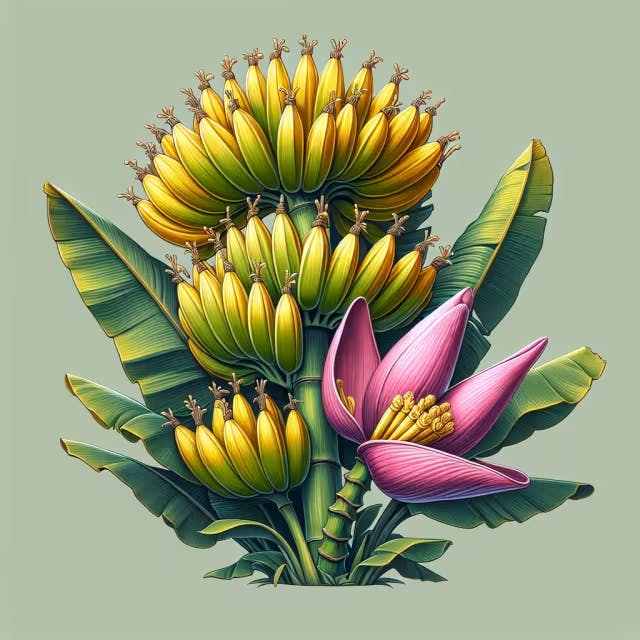
Dive into the fascinating world of "The Beauty of Blooming Bananas: A Gardener's Guide", where we unravel the secrets behind nurturing these iconic tropical delights right in your garden. Transform your gardening experience with our comprehensive guide, designed for a broad audience keen on understanding how the luscious banana flowers blossom and yield the fruit that dominates kitchens globally. With bananas originating from the lush landscapes of Indomalaya and Australia and now thriving in gardens like yours, discover essential care tips, the significance of their flowering stages, and how to embark on a culinary adventure with banana flowers.
Key Takeaways
Banana plants, native to Indomalaya and Australia, can thrive in personal gardens under proper care.
Identifying the optimal conditions for banana plants to bloom involves understanding their natural cycle, which includes when and how their flowers blossom.
Essential care tips for blooming banana plants are crucial for ensuring the healthy growth of the plants and the successful development of fruits.
The flowering stage of the banana plant holds significant importance in the garden, indicating the plant's readiness to produce fruit.
Harvesting banana flowers offers a unique culinary adventure, with the flowers being a versatile ingredient in various dishes.
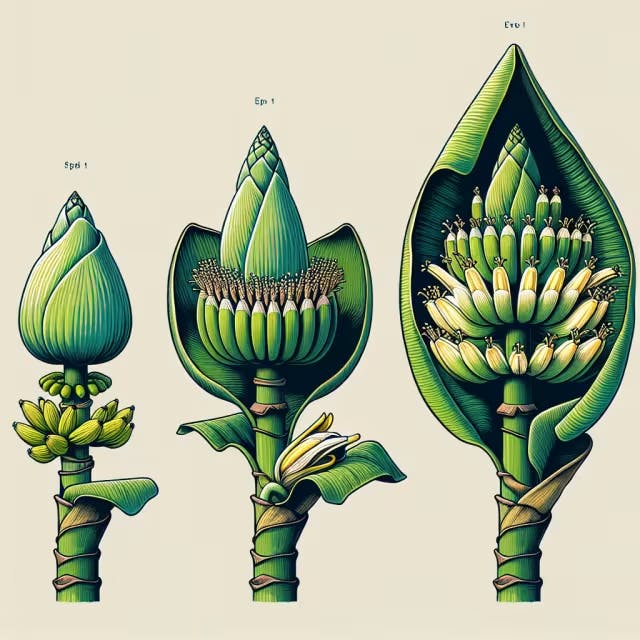
Understanding Banana Plant Blooms: How and When
Banana plants, belonging to the genus Musa, are known for their lush, tropical appearance and delicious fruit. Originating from tropical Indomalaya and Australia, these plants have a significant presence in gardens and homes across the world. Understanding the blooming process of banana plants is essential for any gardener looking to cultivate these beauties successfully.
Bananas grow from a rhizome or corm and develop into large herbaceous plants with pseudostems made from leaf sheaths. Unlike common belief, what appears as a tree trunk is not wood but tightly packed leaves. A fascinating aspect of their growth is the way bananas produce their fruit. The flower spike, emerging from the heart of the plant, gradually unfurls beautiful large flowers that later develop into banana clusters known as 'hands'.
The blooming period can vary depending on the banana variety and growing conditions but typically occurs when the plant is 10-15 months old. Proper care, including adequate water, sunlight, and nutrients, can encourage healthy growth and timely blooming.
Here's a glance at the growth timeline of banana plants:
Age (Months) | Stage |
0-3 | Plant establishment |
3-6 | Rapid leaf production |
6-9 | Flower spike formation |
9-12 | Flowering and fruit setting |
12-15 | Fruit maturity |
Given the right conditions, a banana plant can produce a towering flower spike, leading to a bountiful harvest. After fruiting, the main pseudostem dies but is quickly replaced by offshoots or 'suckers' from the base, ensuring the cycle continues. For those in cooler climates, growing bananas indoors or in a greenhouse can simulate their native tropical habitat, allowing for successful flowering and fruiting.
For more detailed information on banana cultivation, their origins, and uses, exploring comprehensive resources like this article on bananas can offer invaluable insights into the fascinating world of these tropical plants.
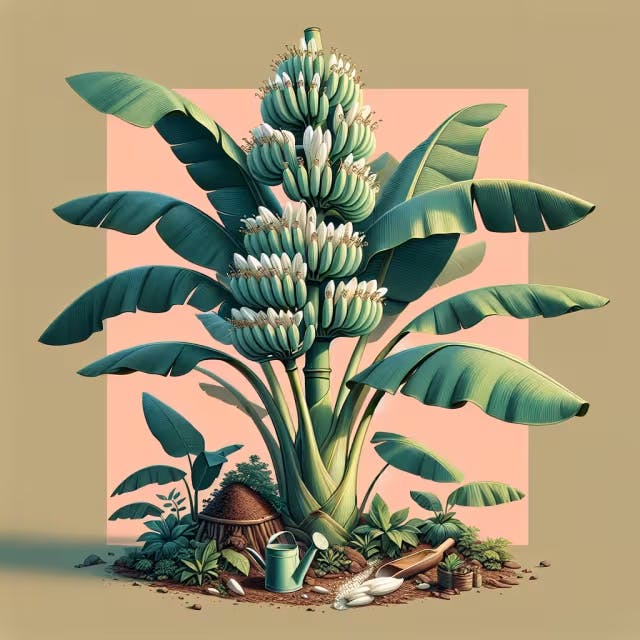
Essential Care Tips for Blooming Banana Plants
Caring for banana plants during their blooming phase requires attentive gardening practices to ensure vibrant flowers and eventual fruit production. Here are some key tips:
Water Wisely: Banana plants love moisture. Water deeply, allowing the soil to stay consistently moist but not waterlogged.
Sunlight: These tropical natives thrive in full sun to partial shade. Ensure they receive at least 6 hours of sunlight daily.
Soil and Fertilization: Use a well-draining, fertile soil. High potassium fertilizer supports blooming and fruiting, apply monthly during the growing season.
Protection: Shield plants from strong winds and cold temperatures. If you're in a cooler climate, consider growing bananas in pots to move them indoors during harsh weather.
Remember, patience and consistent care are key to enjoying the beauty of blooming bananas.
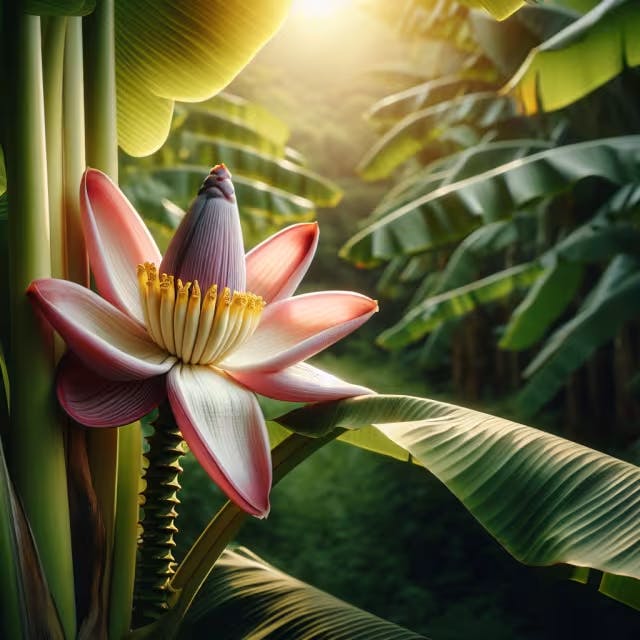
The Significance of Banana Flowering in Your Garden
The moment a banana plant blooms in your garden, it marks a significant milestone, not just in its growth cycle but also as an aesthetic and culinary delight. The dramatic flowering of banana plants, featuring large, exotic blossoms, can add an unparalleled beauty to any garden setting. These flowers, often hidden under the large leaves, eventually emerge, displaying hues of purple, red, and yellow.
Environmental Indicator: Banana blossoms indicate healthy plant development.
Understanding this flowering phase is crucial for gardeners aiming to nurture their plants from flowering to fruiting. It's a visual treat that also signifies the plant's readiness to produce fruit. Here's a closer look at what the banana flower brings to your garden:
Aspect | Detail |
Aesthetic | Adds exotic beauty |
Culinary Use | Flowers are edible |
Indicator | Signals fruit production phase |
Moreover, banana flowers hold culinary value. In many cultures, they are used in cooking, offering a unique taste and texture to dishes. Incorporating them into your diet can be an exciting way to utilize every part of the plant you've grown.
Caring for your banana plant during and after the flowering stage ensures successful fruit production. Regular watering, proper fertilization, and pest control are essential steps to take. Watching your banana plant bloom and ultimately bear fruit is a fulfilling experience for any gardener, signifying the fruits of their labor in the most literal sense.
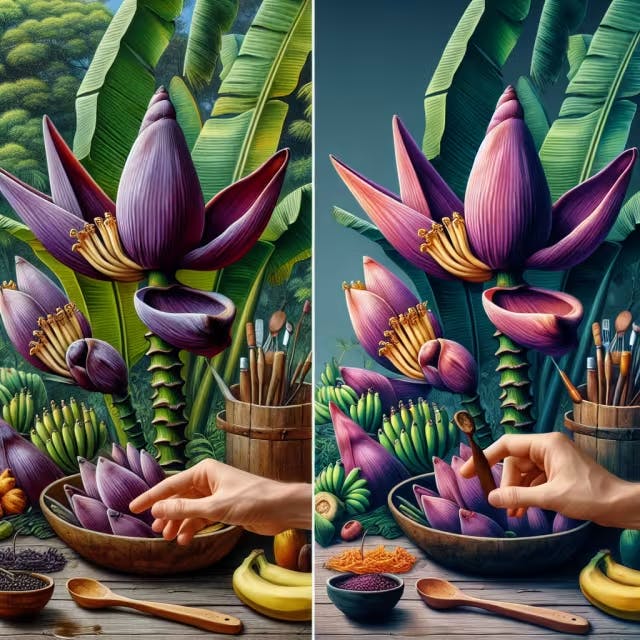
Harvesting and Utilizing Banana Flowers: A Culinary Adventure
Banana flowers, often overshadowed by the fruit, offer a unique culinary experience. Packed with vitamins and minerals, these blossoms can be transformed into sumptuous dishes. To harvest, choose the maroon outer layers that are still tightly closed around the heart. It's crucial to remove the outer petals and the tiny, undeveloped bananas inside, which are bitter.
Here's how to prepare banana flowers for cooking:
Peel away the dark outer layers until you reach the paler, tender heart.
Slice the heart and soak it in lemon-infused water to prevent browning.
Incorporate banana flowers into your diet with these ideas:
Salads: Thinly sliced banana flower adds crunch and nutrition.
Curries: A staple in Southeast Asian cuisine, it absorbs flavors wonderfully.
Fritters: Deep-fried for a crispy, savory snack.
Remember, like making perfect compost, preparing banana flowers requires patience and attention to detail. Just as avoiding common mistakes in worm composting leads to a thriving garden, carefully preparing banana flowers unlocks their culinary potential. In conclusion, the journey of growing bananas, from understanding their blooming process to the eventual harvesting of their flowers for culinary uses, is a rewarding adventure for any gardener. Following the essential care tips provided will ensure the successful cultivation of these magnificent plants, enriching your garden with their beauty and your table with their bounty. Embrace The Beauty of Blooming Bananas: A Gardener's Guide to unlock the full potential of these remarkable plants in your garden.
Frequently Asked Questions
What are the ideal conditions for banana plant blooming and fruit production?
Banana plants thrive and produce fruit under specific conditions: they need consistent moisture without being waterlogged, at least 6 hours of sunlight daily, and well-draining, fertile soil enriched with high potassium fertilizer monthly during the growing season. Protecting the plants from strong winds and cold temperatures is crucial, especially in cooler climates where growing bananas in pots for easy indoor relocation during harsh weather is recommended. Additionally, understanding the growth timeline—from plant establishment to rapid leaf production, flower spike formation, flowering, and fruit setting to maturity—is essential in managing care throughout the different stages for successful blooming and fruit production.
How can I support my banana plant during the flower spike formation and flowering stages?
To support your banana plant during the flower spike formation and flowering stages, ensure you provide consistent care tailored to its needs. Regularly water the plant to maintain moist soil without waterlogging and position it to receive at least 6 hours of sunlight daily. Apply a high-potassium fertilizer monthly to promote healthy blooming and fruit setting. Protect the plant from strong winds and cold temperatures, and if in a cooler climate, consider growing it in a pot to easily move indoors during unfavorable weather conditions. These steps, coupled with patience, will aid in the successful transition from blooming to fruit production.
What makes the flowering stage of banana plants significant for gardeners?
The flowering stage of banana plants is significant for several reasons:
Aesthetic and Culinary Delight: The emergence of large, exotic blossoms adds unparalleled beauty to gardens, transforming them into a tropical paradise. Additionally, banana flowers are edible and valued in various cuisines, offering a unique taste and texture to dishes.
Indicator of Fruit Production: The appearance of flowers signals the plant's readiness to produce fruit. This phase is crucial for gardeners aiming to harvest their own bananas, as it marks a significant milestone in the plant's growth cycle.
Caring for banana plants during the blooming phase involves attentive practices like adequate watering, proper fertilization, and ensuring enough sunlight. This care not only supports the health of the plant but also encourages successful fruit production following the bloom.
How can banana flowers be used in cooking and what are their nutritional benefits?
Banana flowers, rich in vitamins A and C, dietary fiber, potassium, and iron, offer substantial health benefits, including improved digestion and reduced menstrual pain. They are used in various culinary practices primarily in Asian cuisine. Preparation involves peeling away the outer petals to reveal the tender heart, which is then sliced and soaked in lemon-infused water to prevent browning. Here's how they can be incorporated into meals:
Salads: Add them thinly sliced for a nutrient-rich, crunchy element.
Curries: Known for their ability to soak up flavors, banana flowers make a delicious addition to curries.
Fritters: Chop finely and mix into batter for deep-fried delights.
These uses showcase banana flowers' versatility in cooking, turning the underutilized part of the banana plant into a source of nutrition and exotic flavors.
What are the steps to prepare banana flowers for culinary use?
To prepare banana flowers for culinary use, start by selecting a flower with maroon outer layers that are still tightly closed around the heart. Follow these steps:
Remove Outer Petals: Gently peel away the darker, tougher outer petals to expose the paler, tender heart within. Discard the outer layers and any tiny, undeveloped bananas found inside, as they are bitter.
Slice and Soak: Thinly slice the tender heart and immediately soak the slices in lemon-infused water. This prevents the banana flower from turning brown and maintains its fresh appearance and taste.
Banana flowers can be used in a variety of dishes, from crisp salads and hearty curries to savory fritters, offering a unique flavor and texture to your meals.